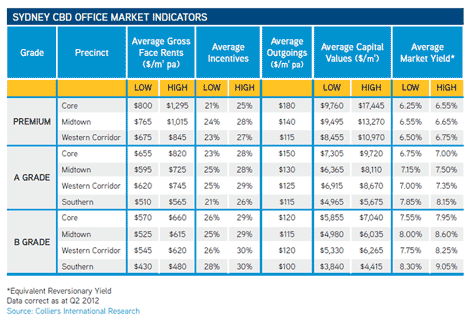Melbourne trumps Sydney on office investment sales activity but not on short-term outlook: Colliers International
Melbourne recorded $629.5 million worth of commercial office CBD investment sales over the first six months of year, trumping Sydney, which managed $478.6 million of sales, according to new research by Colliers International of sales worth $20 million or more.
The biggest whole asset sale in Melbourne over the first six months of the year was 150 Collins Street, which was purchased by GPT Wholesale Office Fund for $181 million on a yield of 6.77%.
Sydney’s most expensive single asset sale was Macquarie Bank’s $131 million vacant possession purchase of 48 Martin Place on yield around 7% and 7.5% (as estimated by Knight Frank).
The only premium-grade asset sale in Sydney during the first half of 2012 was the 25% acquisition of 126 Phillip Street for $176 million by Investa Commercial Fund from Investa on a yield of 6.35%.
Of the two office markets, Sydney has the brighter short-term outlook, with Melbourne's vacancy rate expected to continue to rise.
Colliers says that despite a large number of buyers chasing better-quality assets across Melbourne’s CBD office market, “the short-term outlook for transaction volumes remains subdued”.
“This is a function of the lack of investment-grade stock on the market for sale, as opposed to low levels of demand.
“As a result we expect face rents to remain stable while incentives will experience further increase, as landlords look to offer more to attract and secure tenants. This will in turn lead to further declines in effective rents across all grades over the next 12 months.”
In the case of the Sydney CBD market, Colliers expects leasing and tenant enquiry activity to remain “buoyant from smaller non-CBD based tenants who are looking to take advantage of softer market conditions to evaluate and upgrade their tenancies”.
“Limited supply entering the market and positive absorption over the remainder of 2012 is expected to see vacancy rates decline across the Sydney CBD office market.
“This is expected to result in subdued rental growth and a stabilisation of incentives over the period.”
The most recent Property Council of Australia office report recorded that the Melbourne CBD office vacancy rate increased from 5.2% to 5.6% from January to July, while Sydney recorded a 1.5 percentage point contraction from 9.7% in January to 8.2% in July – the largest decline of all CBD markets over this period.
Colliers International forecasts the Sydney CBD vacancy rate to decline further over 2012 to 7.9% by January 2013, before rising slightly to 8.2% as of July 2013.
In contrast the Melbourne CBD vacancy rate is expected to trend upwards to peak at 7.5% by July 2013 as 234,000 square metres of new supply comes on board over the next two years – before starting to trend downwards again.
Colliers attributes the decline in the Sydney CBD office vacancy rate to a “distinct lack of supply”, with only 13,225 square metres entering the market over the first six months of the year, combined with a positive absorption result of 45,300 square metres during the period.
Renting premium and A-grade office space in Melbourne remains significantly cheaper than in Sydney.
According to Colliers, top-of-town Melbourne premium office rents range from $480 to $665, with A-grade office rents ranging from $392 to $457.
Premium core Sydney CBD office rents start from $800 to $1,295 while core A-grade rents range from $650 to $820.
Click to enlargeRental returns are quite similar for premium-grade and A-grade assets in both capital cities.
Premium Sydney office yields have remained stable in six months to July 2012, sitting between 6.25% and 6.75%, while A-grade yields also remained stable during this period, recording between 6.75% and 8.15%.
Premium Melbourne yields also remained stable in six months to July 2012, sitting between 6.50% and 7% while A-grade yields also remained stable during this period, falling in a range between 7% and 7.75%.
Click to enlargeJohn Marasco, Colliers International managing director of investment services, says Sydney prime grade yields have stabilised, while the yield spread between high- and low-quality secondary-grade assets has continued to widen.
“Quality office buildings, particularly premium and A-grade, that offer a weighted average lease expire (WALE) of four years or greater continue to be in high demand from investors.
“A lack of this type of property on the market for sale has seen sales volumes remain low, and this has led to the stabilisation of prime grade yields during the first half of this year,” he says.
“The outlook for the next six months is overwhelmingly positive, as the number of genuine enquires for investment properties in Sydney’s CBD has increased since the end of the 2011-12 financial year,” he says.
“We predict this will translate into a greater number of assets sold in the second half of 2012, with Sydney ending the year on a definite high.”
Nerida Conisbee, Colliers International national director of research, says Melbourne CBD office property remained highly sought after despite a rising vacancy rate and declining rents, with Premium and A-Grade stock experiencing particularly strong demand.
Marasco says good quality Melbourne CBD assets continue to attract “keen interest and this interest is coming from a range of different buyer types.
“A high proportion of demand is coming from offshore, but there should also be no underestimating the level of active domestic capital.”

